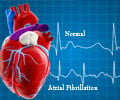The relationship between physical fitness and a lowered probability of atrial fibrillation and stroke occurrence has been established.

Exercise performance and the risk of incident atrial fibrillation
Go to source). Atrial fibrillation is the most common heart rhythm disorder, affecting more than 40 million people worldwide (2✔ ✔Trusted Source
ESC Guidelines for the diagnosis and management of atrial fibrillation developed in collaboration with the European Association of Cardio-Thoracic Surgery
Go to source). It is estimated that one in three Europeans will develop atrial fibrillation in their lifetime. Patients with the condition have a five-fold higher risk of stroke than their peers. This study examined whether fitness was related to the likelihood of developing atrial fibrillation.
‘Maintaining fitness could aid in the prevention of atrial fibrillation and stroke. #HeartDiseaseFitness #ExerciseBenefits #ArtrialFibrillation #Stroke’





The study included 15,450 individuals without atrial fibrillation who were referred for a treadmill test between 2003 and 2012. The average age was 55 years and 59% were men. Fitness was assessed using the Bruce protocol, where participants are asked to walk faster and at a steeper grade in successive three-minute stages. Fitness was calculated according to the rate of energy expenditure the participants achieved, which was expressed in metabolic equivalents (METs).
Exploring the Impact of Fitness on Atrial Fibrillation, Stroke, and Cardiovascular Events
Participants were followed for new-onset atrial fibrillation, stroke, myocardial infarction and death. The researchers analysed the associations between fitness and atrial fibrillation, stroke and major adverse cardiovascular events (MACE; a composite of stroke, myocardial infarction and death) after adjusting for factors that could influence the relationships including age, sex, cholesterol level, kidney function, prior stroke, hypertension and medications.During a median of 137 months, 515 participants (3.3%) developed atrial fibrillation. Each one MET increase on the treadmill test was associated with an 8% lower risk of atrial fibrillation, 12% lower risk of stroke and 14% lower risk of MACE.
Participants were divided into three fitness levels according to METs achieved during the treadmill test: low (less than 8.57 METs), medium (8.57 to 10.72) and high (more than 10.72). The probability of remaining free from atrial fibrillation over a five-year period was 97.1%, 98.4% and 98.4% in the low, medium and high fitness groups, respectively.
References:
- Exercise performance and the risk of incident atrial fibrillation - (https://esc365.escardio.org/ESC-Congress/sessions/7964)
- ESC Guidelines for the diagnosis and management of atrial fibrillation developed in collaboration with the European Association of Cardio-Thoracic Surgery - (https://pubmed.ncbi.nlm.nih.gov/32860505/)















